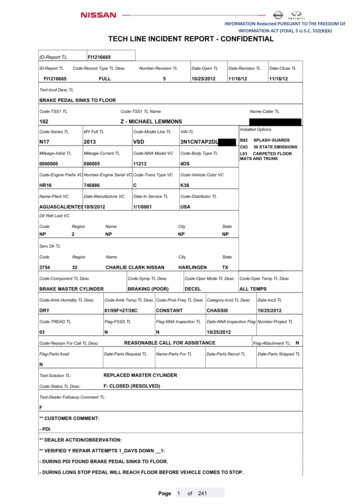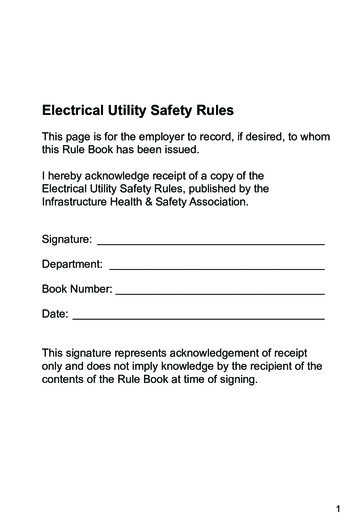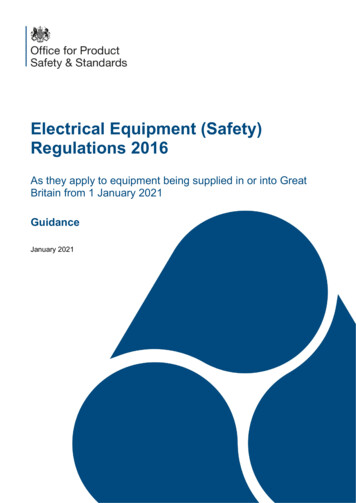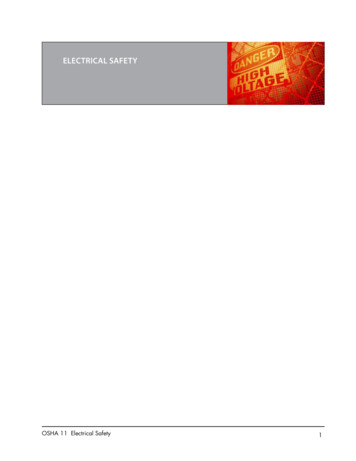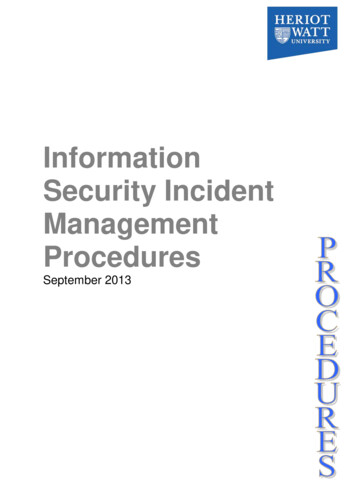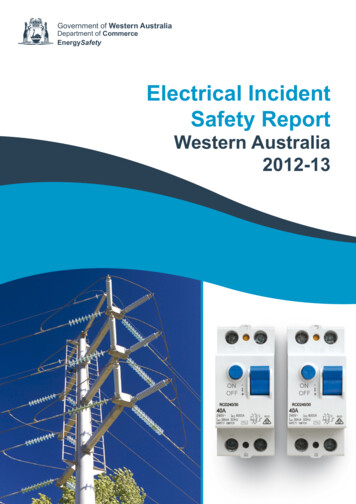
Transcription
Government of Western AustraliaDepartment of CommerceEnergySafetyElectrical IncidentSafety ReportWestern Australia2012-13
TABLE OF CONTENTS1.Executive Summary 22.Introduction 33.Definitions and Explanatory Notes 44.5.6.7.3.1Fatalities, Accidents and Shocks 43.2Installation Types 43.3Occupations 53.4Statistical Divisions 6Electrical Fatalities 74.1Recent Fatal Electrical Incidents in WA 74.2Historical Information 74.3Interstate and National Comparisons 114.4Workplace and Non-Workplace Fatalities 144.5Age of Deceased 174.6Primary Electrical Contributors 184.7Installation Type and Location 204.8Time of Year/Climate 22Electrical Accidents 235.1Historical Information 235.2Workplace and Non-Workplace Accidents 255.3Age of Victims 275.4Primary Electrical Contributors 285.5Installation Type and Location 295.6Time of Year/Climate 29Electrical Shocks 306.1Historical Information 306.2Workplace and Non-Workplace Incidents 32Conclusion 34Electrical Incident Safety Report Western Australia 2012-13
PrefaceThis report by EnergySafety summarises statistical information about electrical incidentsin Western Australia during 2012-13 fiscal year. EnergySafety is the electricity regulator inWestern Australia.The report provides information on how safely the State’s industry and general communityare operating in the supply and use of electricity.EnergySafety uses the information to make assessments about: The effectiveness of safety education and regulatory measures (including mandatorytechnical requirements); and The changes that should be considered to improve industry and community electricalsafety outcomes.These assessments are the subject of continuing policy work by EnergySafety, whichinclude extensive consultation with electrical contractors, unions, training organisations andthe Electrical Licensing Board.I am confident that the report will interest those involved in the State’s electrical industry.Ken BowronDirector of Energy SafetyJune 20141Electrical Incident Safety Report Western Australia 2012-13
1. Executive SummaryThis report presents an analysis of electrical incidents reported to EnergySafety WA in thefiscal year 2012-13. The analysis has also been based on incidents reported over a 10 yearperiod from 1 July 2003 to 30 June 2013.The report examines three categories of incidents – fatality, accident and shock. Its aim isto provide a statistical basis for future recommendations to reduce the risks associated withelectricity.From 1 June 2003 to 30 June 2013, 28 electrical fatalities occurred in Western Australia, 18within the Perth metropolitan area and 10 in regional areas. Although the rate of fatalitiesin the Perth metropolitan area remained relatively stable in previous years, the recent trenddepicts a radical reduction. The trend is influenced by the reality of nil fatalities in the metroarea over the past two years. Regional areas have shown a substantial increase againinfluenced by the two fatalities that occurred in regional WA in 2012-13.Western Australia’s Fatal Injury Frequency Rate (FIFR) in 2012-13 was 0.8 per millionpersons.Approximately 46 percent of fatalities occurred in a workplace environment with electricalworkers forming 47 percent of this category. Among non-workplace categories, the groupmost at risk is home-based members of the general public, including children, students andretired persons.In the 10 year reporting period, fixed wiring has remained the primary contributor in 32percent of reported electrical fatalities, followed by tools/appliances at 29 percent. Mostfatalities occurred in the months of December, January and February.There were 195 serious electrical accidents and 11,526 shocks reported since July 2003. Incomparison to the previous year there has been a reduction in reported electrical accidents.The reduction in the number of accidents may be attributed to improved work practicesstemming from improvements in the electrical installation standards and other electricalguidelines issued by EnergySafety as well as successful safety campaigns.Electrical Incident Safety Report Western Australia 2012-132
2. IntroductionEnergySafety administers the Electricity (Licensing) Regulations 1991 and the Electricity(Supply Standards and System Safety) Regulations 2001. A common element to bothpieces of legislation is the mandatory reporting of all electrical accidents causing or likelyto cause, danger to life or property to the Director of Energy Safety and the relevantnetwork operator. The incidents reported to the Director of Energy Safety are recorded andpresented as a number of reported accidents per million population.In the case where an electrical accident involves an employee it is acceptable for theincident to be reported to the employer in the first instance who in turn must report it to therespective network operator. It is the responsibility of the network operator to report theincident to the Director of Energy Safety.This report focuses on the 10 year period from 1 July 2003 to 30 June 2013. It takes intoaccount all reported incidents recorded into the EnergySafety database. The incidentshave been categorised into fatalities, accidents and shocks. The ‘Accident Triangle’ belowillustrates the proportion of reported incidents in each category in Western Australia for thereporting period.28Fatalities197Accidents11526ShocksThe information compiled in this report has been retrieved from the EnergySafety databaseand the merging of data from other regulatory jurisdictions in Australia and New Zealand.The report provides a comparative analysis of electrical fatalities and their trends1.Although electrical accident and shock trends have been analysed in this report, they havenot been compared with other jurisdictions.EnergySafety thanks the regulatory jurisdictions of the States and Territories of Australiaand New Zealand for their contribution to this report.1Due to issues with data availability, interstate and national comparisons have been evaluated on the nine yearsfrom 2003-04 to 2011-12.3Electrical Incident Safety Report Western Australia 2012-13
3. Definitions and Explanatory Notes3.1Fatalities, Accidents and Shocks3.1.1 Electrical FatalityAn electrical fatality (electrocution) is defined as a death directly resulting from a suddendischarge of electricity, excluding a fatality deemed a result of wilful self-electrocution.3.1.2 Serious Electrical AccidentA non-fatal incident resulting from a sudden discharge of electricity causing injurysufficient to require first-aid or medical attention as either an inpatient or outpatient,excluding attendance for a precautionary electrocardiograph (ECG).3.1.3 Electric ShockA non-fatal incident resulting from a sudden discharge of electricity, but not includingstatic discharge, causing insufficient injury to require first aid or medical attention. Note:Where the only treatment required is attendance for a precautionary electrocardiograph(ECG), the incident is classified as an electric shock.3.1.4 Electrical IncidentAn electrical incident refers to an electrical fatality, serious electrical accident or electricshock.3.1.5 FIFR (Fatal Injury Frequency Rate)A measure of the number of electrical fatalities in a given period, expressed per millionpersons in a population.3.2Installation Types3.2.1 MiningThe definition of mining operations used in this report is that appearing in the MinesSafety and Inspection Act 1994.3.2.2 CommercialFor the purposes of this report, commercial installations are those in a businesspremise area accessible to customers and not involving industrial processing activities.Commercial sites include, but are not limited to, offices, retail premises, restaurantpublic areas, hospital patient areas, railway platforms and carriages, classrooms, ovalsand parks. Storerooms, warehouses, commercial kitchens and fishing boats are alsoconsidered to be commercial sites.Electrical Incident Safety Report Western Australia 2012-134
3.2.3 IndustrialIndustrial installations are considered to be those involving manufacturing processesor normally subject to restricted public access for safety reasons. Industrial sitesinclude factory floors, workshops, commercial railway tracks and overhead lines andconstruction sites.3.2.4 RuralA rural installation comprises any aerial distribution system extending from the property‘point of supply’ (usually a pole mounted transformer), the electrical installation withinbuildings on the property (excepting the primary residence which is domestic bydefinition) and other installations such as pumps, irrigation equipment and any otheragricultural or horticultural equipment. Excluded is the network operator’s transmissionand/or distribution equipment (eg aerial conductors and poles).3.2.5 DomesticAn installation in a private dwelling, apartment/flat or living unit utilised for residentialpurposes.3.2.6 Network OperatorNetwork operator installation type refers to the transmission, distribution and serviceapparatus used to distribute electricity to consumers.3.3Occupations3.3.1 Occupational ClassificationsOccupational classifications used in this report are in line with the taxonomy used inthe Australian Bureau of Statistics’ Australian Standard Classification of Occupations(Second Edition). Note: Occupational classifications are distinct from occupationalcategories (see below).3.3.2 Occupational CategoriesIndividuals have been allocated to one of four occupational categories depending ontheir activity at the time of the electrical incident. Those at work have been divided intosupply worker (ie those employed by a network operator), other electrical worker andnon-electrical worker, while general public or community refers to all those involved in anelectrical incident which occurred outside the course of their paid employment.5Electrical Incident Safety Report Western Australia 2012-13
3.3.3 Electrical WorkerFor the purposes of this report, an electrical worker is defined as a person carrying outelectrical work who, is licensed or authorised to do so under the Electricity (Licensing)Regulations 1991. This definition encompasses electricians and holders of restrictedelectrical licences, electrical apprentices, electrical fitters and electrical mechanics.3.3.4 ElectricianAn electrician is defined as a person holding an electrician’s licence and those who priorto1 July 2008, held an ‘A’ Grade electrical worker’s licence endorsed as either an electricalfitter or electrical mechanic (or both) to perform electrical work in accordance with theElectricity (Licensing) Regulations 1991.3.3.5 Restricted Electrical WorkerA restricted electrical worker is defined as a person (not including an electrician)licensed in accordance with the Electricity (Licensing) Regulations 1991 to carry outspecific types of limited electrical work associated with, or for the purposes of, thelicence holder’s trade or calling.3.3.6 Electrical ApprenticeAn electrical apprentice is defined as a person holding an Electrician’s Training Licencewho, prior to 1 July 2008, held a ‘C’ Grade electrical worker’s licence and was thereforelicensed to perform electrical work under supervision in accordance with the Electricity(Licensing) Regulations 1991 as part of a registered industry training program.3.4Statistical Divisions3.4.1 PopulationPopulation statistics used in this report are obtained from the Australian Bureau ofStatistics [ABS] (www.abs.gov.au/ausstats) and Statistics New Zealand [SNZ](www.stats.govt.nz). Census statistics are used where available; otherwise all populationfigures are estimated resident populations as available on the ABS and SNZ websiteson September 2010.3.4.2 Metropolitan/CountryThe boundaries of the metropolitan area used in this report are the Metropolitan Area(Scheme Boundary).Electrical Incident Safety Report Western Australia 2012-136
4. Electrical Fatalities4.1Recent Fatal Electrical Incidents in WAIn 2012-13 two fatalities were reported in Western Australia where electricity was foundto be the cause. A portable generator was being used to charge a car battery. The victim mistakenlyplugged in the 12 volt DC charging cord into the generator’s 240 ac volt socket outletand received a fatal electric shock when he contacted the DC charging connectors. A trade assistant was working in a roof space assisting an electrician to pull cablesthrough a conduit into the roof space. The cables were live as they had not beenisolated. The victim received a fatal electric shock when he made contact with thelive ends of the cable.In both cases, no residual current device (RCD) was fitted on the circuit, which couldhave prevented the fatality.During the 2009-10 financial year EnergySafety implemented the compulsory fitting ofRCD’s in dwellings (house or unit) prior to their sale and within two years in the caseof leased premises. A successful press advertising campaign was carried out to informthe public about the benefits of installing an RCD. EnergySafety continues to addressresponses to technical issues raised by electrical contractors, property owners andmanagers.Another RCD campaign was held in latter half of the 2010-11 financial year. However,there is still a requirement to educate the public on the use of RCDs and need toregularly test that they work properly.7Electrical Incident Safety Report Western Australia 2012-13
4.2Historical InformationIn the 10 years from 1 July 2003 to 30 June 2013 there were 28 electrical fatalities inWestern Australia. Of these, 18 occurred within the Perth metropolitan area and a further10 in regional areas (Chart 1).EnergySafety conducted a safety awareness campaign during the 2003-04, 2005-06,2007-08, 2009-10 and 2011-12 fiscal years. Chart 1 demonstrates that there have beenfewer fatalities during these years, supporting the theory that advertising about electricalsafety contributes to a reduction in the number of electricity-related fatalities.Retrofitting RCDs into older installations in other states has proven to be effective. It wasintroduced as a condition of sale and leasing of residential properties in WesternAustralia in 2009-10. The requirement for at least two RCDs to be installed in rentedresidential dwellings constructed post 1992 came into force on 9 August 2009 inWestern Australia.CHART 1: ELECTRICAL FATALITIES IN WA - 2003-04 to 2012-136432Regional 72005-0602004-0512003-04NUMBER OF FATALITIES5Perth MetroElectrical Incident Safety Report Western Australia 2012-138
CHART 2: WA ELECTRICAL FATALITIES PER MILLION POPULATION6NUMBER OF lities Per MillionFatalities per million population for Western Australia vary between two and four personsper million with the exception of 2007-08 and 2011-12 where there were fewer fatalities(Chart 2). Over the last five years fatalities averaged 2.4 per million population. Thetrend for fatalities has been on the decline over this period (Chart 3).CHART 3: WA ELECTRICAL FATALITIES AND FATAL INCIDENT TRENDS65432Fatalities Trend9Fatalities Per Million TrendElectrical Incident Safety Report Western Australia 006-072005-062004-0502003-041
Chart 3 indicates a positive outcome for electrical safety in Western Australia, withfatalities in each year and the rate per million people decreasing. While WesternAustralia’s population increased by 27 percent from 1,982,637 people in July 2003 to2,517,232 in June 2013, fatalities per million have fallen.A contributing factor to the reduction may be the mandatory installation of residualcurrent devices (RCDs, known also as safety switches) since 1992 in new or modifiedelectrical installations.Additionally, the 9 August 2009 amendment places the onus on the owner of theproperty to ensure that two RCDs are fitted prior to transfer of the property title and,in the case of rented property, prior to entering into a new tenancy agreement. Sinceits implementation the change has and will continue to provide safety to electricalinstallations in residential premises.In analysing the electrical fatalities for Western Australia, it is of interest to note thecomparative trends between the Perth metropolitan area and Western Australia’sregional and rural areas (Chart 4). Previous statistical analyses of the rate of fatalitiesin the Perth metropolitan area reflected a stable trend. The recent trend indicates asignificant reduction, due to zero fatalities in the metropolitan area over the past twoyears. Regional areas have shown an increase, with two fatalities occurring in regionalWA in 2012-13.CHART 4: WA ELECTRICAL FATALITIES TRENDS BY METRO & REGIONAL AREAS3221Perth Metro Fatalities Per Million 6-072005-062004-0502003-041Regional WA Fatalities Per Million TrendElectrical Incident Safety Report Western Australia 2012-1310
4.3Interstate and National ComparisonsHistorically, Western Australia has been compared with Victoria and Queensland whenanalysing the electrical safety performance 2 (Chart 5).CHART 5: ELECTRICAL FATALITIES PER MILLION POPULATION2.52.01.51.0Western raliaQueensland has a climate similar to Western Australia, with the exception of thesouthwest region, and therefore provides opportunities for comparison. The trend forQueensland in the period 2003-04 to 2011-12 indicates a slight increase in the numberof fatalities duri
An electrical fatality (electrocution) is defined as a death directly resulting from a sudden discharge of electricity, excluding a fatality deemed a result of wilful self-electrocution. 3.1.2 Serious Electrical Accident A non-fatal incident result

